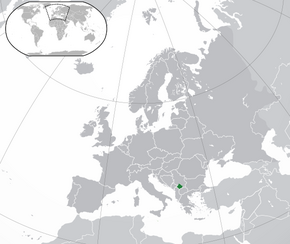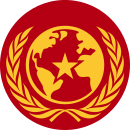More languages
More actions
| Republic of Kosovo Republika e Kosovës (Albanian) Република Косово (Serbian) | |
|---|---|
 | |
| Capital and largest city | Pristina |
| Official languages | Albanian Serbian |
| Demonym(s) | Kosovar, Kosovan |
| Dominant mode of production | Capitalism |
| Government | Unitary parliamentary republic |
• President | Vjosa Osmani |
• Prime Minister | Albin Kurti |
• Speaker of the Assembly | Glauk Konjufca |
| History | |
• Seceded from Serbia | 17 February 2008 |
| Area | |
• Total | 10,887 km² |
| Population | |
• 2024 census | 1,585,566 |
| Currency | Euro (€) (EUR) |
| Driving side | right |
| Calling code | +383 |
| ISO 3166 code | XK |
The Republic of Kosovo is a Balkan country in southeastern Europe that is a neocolony occupied by the US and NATO. It is bordered by North Macedonia to the south, Albania and Montenegro to the west and Serbia to the north and east. Serbia continues to claim Kosovo as its Autonomous Province of Kosovo and Metohija due to its illegal secession from Serbia in 2008 and as such the state has limited recognition internationally.[1]
History[edit | edit source]
Medieval Ages[edit | edit source]
Before Slavs first came to Kosovo in the 6th century, the area was inhabited by a Dardani tribe. Slavic immigrations into Kosovo began during the reign of Justinian.[2] Kosovo's first Slavs were noted to be Bulgarians under Khan Presian when Kosovo was incorporated into Bulgaria in the 9th century.[3] Between 1072 and 12th century, Kosovo was part of the Byzantine rule until the Nemanjić dynasty came in late 12th century and began incorporating Kosovo until accomplishing it by 1219.[4]
Second World War[edit | edit source]
During the Second World War, Albanian fascists expelled 70,000 Serbs from Kosovo and brought in a similar number of Albanians from Albania. The Nazi 21st SS division murdered thousands of Serbs in northeastern Kosovo.[5]:95
Yugoslavia[edit | edit source]
Tito made Kosovo an autonomous region after the war and then an autonomous province in 1963 in order to placate Albanian nationalists. In 1974, Yugoslavia adopted a new constitution that weakened the central government and gave more power to regional authorities in Kosovo. Kosovo had its own flag and supreme court, and all non-university education was in Albanian. Even though it only had 8% of Yugoslavia's population, it received 24% of the federal development budget.
In 1987, the newly elected Slobodan Milošević began to take action against Albanian secessionists. In 1989, he repealed the 1974 constitution that allowed Kosovo to veto federal laws. Albanians who opposed the federal government began boycotting elections and many were fired from state employment.[5]:96–98
Yugoslav Wars[edit | edit source]
Until 1992, Kosovo was an autonomous region of the Socialist Republic of Serbia within Yugoslavia. Since 1998, NATO supported the fascist Albanian nationalist KLA.
By 1999, NATO illegally[6] invaded Kosovo under the excuse that Yugoslav forces were committing ethnocides and expulsions. However, Spanish forensic doctors, whom somebody mislead into expecting thousands of bodies to examine, returned home in September 1999 with only 187 bodies.[7] Reuters confirmed in October 1999 that nobody found any corpses at the rumored grave site in Kosovo, and the ICTY’s speaker Kelly Moore said that after ICTY investigators had examined Trepča, ‘They found absolutely nothing.’[8] George Kenney, a now former foreign service officer of Washington’s State Department, remembers looking at various reports of atrocities in Kosovo and thinking that they were ‘complete nonsense’; basing his experience on Bosnia, he realized that the stories were at best inaccurate reports and at worst pure fiction.[9] Contrary to the capitalist media’s much higher estimates,[10] investigators found only some four thousand bodies (including Serbs and military personnel) in Kosovo,[11] and estimated that 2,047 were still missing as of 2007.[12] Capitalist outlets such as the Guardian, the Wall Street Journal, and USA Today eventually admitted that the NATO had grossly exaggerated the scale of the atrocities.[13]
In 1999, Serbian leader Slobodan Milošević surrendered to NATO after the United States bombed Serbia for 78 days. NATO divided Kosovo into five zones occupied by the USA, UK, France, Germany, and Italy. They installed the fascist Kosovo Liberation Army as the new government of Kosovo.[5]
U.S. occupation[edit | edit source]
In early 2000, NATO occupied Kosovo, and the KLA developed into a police force that exiled 200,000 Serbs from Kosovo and killed hundreds. Serbs, Jews, Roma, and other non-Albanian ethnicities suffered from hate crimes and looting. After the NATO occupation began, Albanian supremacists destroyed over two million Serbian-language books. The mafia became very powerful and kidnapped teenagers to send them to Western Europe.
KLA and NATO members assassinated supporters of the Kosovo Democratic League (a less violent separatist group) including its leader, Fehmi Agani. 379 people were murdered in the first five months of occupation: 135 Serbs, 145 Albanians, and 99 people of other ethnicities.[14]
In 2008, the Autonomous Province of Kosovo and Metohija seceded from Serbia.
Demographics[edit | edit source]
Between 1945 and 1998, the non-Albanian population of Kosovo dropped from 60% to 15%. Tito did not prevent Albanians from expelling Serbs and other ethnicities.[15]:96 Serbs only make up 5% of Kosovo's population.[15]
References[edit | edit source]
- ↑ Richard Becker (2007-12-14). "Why the U.S. backs Kosovo ‘independence’" Liberation School. Archived from the original on 2022-05-17. Retrieved 2022-10-28.
- ↑ Noel Malcolm (1998). Kosovo: A Short History (p. 23). Macmillan. ISBN 0333666127
- ↑ Robert Elsie (2010). Historical Dictionary of Kosovo (p. 54). Scarecrow Press. ISBN 9780810874831
- ↑ Günter Prinzing (2008). Demetrios Chomatenos, Zu seinem Leben und Wirken: 'Demetrii Chomateni Ponemata diaphora: [Das Aktencorpus des Ohrider Erzbischofs Demetrios. Einleitung, kritischer Text und Indices]' (p. 30). ISBN 9783110204506
- ↑ 5.0 5.1 5.2 Michael Parenti (2000). To Kill a Nation: 'On to Kosovo'. [PDF] Verso.
- ↑ John Laughland (2007). Travesty: The Trial of Slobodan Milošević and the Corruption of International Justice: '1' (pp. 7–11). Pluto Press.
- ↑ Pablo Ordaz (1999-09-23). "Policías y forenses españoles no hallan pruebas de genocidio al norte de Kosovo"
- ↑ No Bodies at Rumored Grave Site in Kosovo (1999-10-13).
- ↑ "Milošević Trial: Corruption of International Justice".
- ↑ Edward Herman (2010). The Politics of Genocide (p. 50). Monthly Review Press.
- ↑ Carla Del Ponte (2000-12-20). Statement to the Press by Carla Del Ponte
- ↑ International Committee of the Red Cross (2007-08-29). Kosovo: ICRC publishes new edition of ‘Book of the Missing’
- ↑ John Laughland (2007). Travesty: The Trial of Slobodan Milošević and the Corruption of International Justice: '1' (pp. 7–11). Pluto Press.
- ↑ Michael Parenti (2000). To Kill a Nation: 'Ethnic Cleansing, KLA-NATO Style' (pp. 156–160). [PDF] Verso.
- ↑ 15.0 15.1 Michael Parenti (2000). To Kill a Nation: 'On to Kosovo'. [PDF] Verso.


